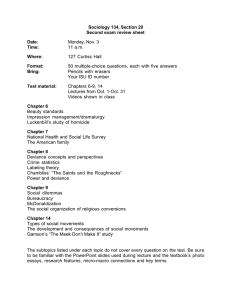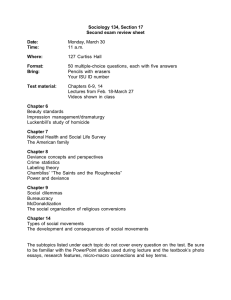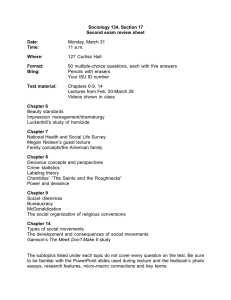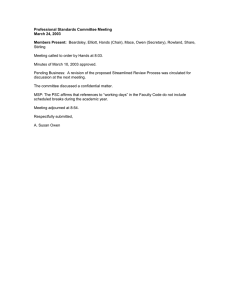11-1. What is power in architecture? Explicate this through the... clients, architects, the function of design, architecture's audience, the public...
advertisement
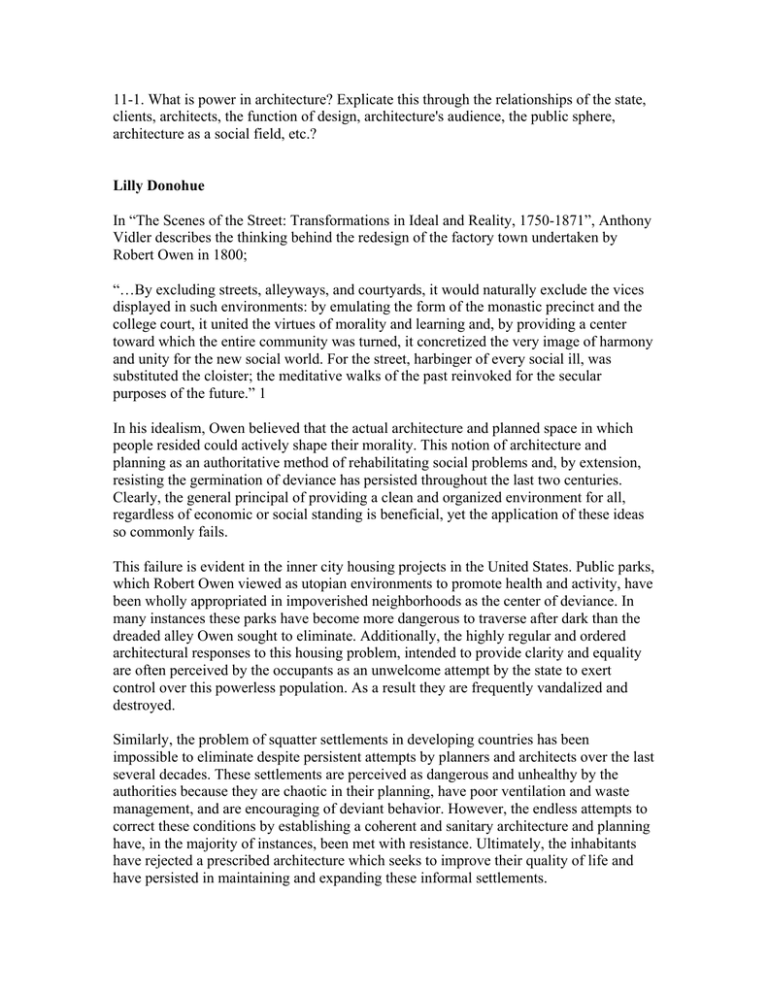
11-1. What is power in architecture? Explicate this through the relationships of the state, clients, architects, the function of design, architecture's audience, the public sphere, architecture as a social field, etc.? Lilly Donohue In “The Scenes of the Street: Transformations in Ideal and Reality, 1750-1871”, Anthony Vidler describes the thinking behind the redesign of the factory town undertaken by Robert Owen in 1800; “…By excluding streets, alleyways, and courtyards, it would naturally exclude the vices displayed in such environments: by emulating the form of the monastic precinct and the college court, it united the virtues of morality and learning and, by providing a center toward which the entire community was turned, it concretized the very image of harmony and unity for the new social world. For the street, harbinger of every social ill, was substituted the cloister; the meditative walks of the past reinvoked for the secular purposes of the future.” 1 In his idealism, Owen believed that the actual architecture and planned space in which people resided could actively shape their morality. This notion of architecture and planning as an authoritative method of rehabilitating social problems and, by extension, resisting the germination of deviance has persisted throughout the last two centuries. Clearly, the general principal of providing a clean and organized environment for all, regardless of economic or social standing is beneficial, yet the application of these ideas so commonly fails. This failure is evident in the inner city housing projects in the United States. Public parks, which Robert Owen viewed as utopian environments to promote health and activity, have been wholly appropriated in impoverished neighborhoods as the center of deviance. In many instances these parks have become more dangerous to traverse after dark than the dreaded alley Owen sought to eliminate. Additionally, the highly regular and ordered architectural responses to this housing problem, intended to provide clarity and equality are often perceived by the occupants as an unwelcome attempt by the state to exert control over this powerless population. As a result they are frequently vandalized and destroyed. Similarly, the problem of squatter settlements in developing countries has been impossible to eliminate despite persistent attempts by planners and architects over the last several decades. These settlements are perceived as dangerous and unhealthy by the authorities because they are chaotic in their planning, have poor ventilation and waste management, and are encouraging of deviant behavior. However, the endless attempts to correct these conditions by establishing a coherent and sanitary architecture and planning have, in the majority of instances, been met with resistance. Ultimately, the inhabitants have rejected a prescribed architecture which seeks to improve their quality of life and have persisted in maintaining and expanding these informal settlements. Deviance in these instances, is the result of a complicated network of issues; poverty, education, environment, etc. Architecture and planning, regardless of how ordered and hopeful its implementation, is ultimately not capable of single-handedly preventing or correcting any particular behavior. Architecture of the state can be used to resist or exert control in the physical sense (barricades, prisons), but when it attempts to intervene in the psychology of the individual in order to exert its control, it cannot be effective without a simultaneous attempt to assist in the larger issues that contribute equally to the propensity towards deviance. 1. Vidler, Anthony. “The Scenes of the Street: Transformations in ideal and Reality, 1750-1871,” p.63
